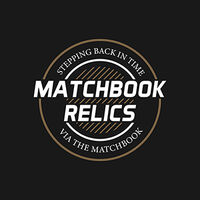In the mid-20th century, funeral homes found an unexpected yet effective promotional tool in vintage matchbooks. These small, everyday items served as subtle and practical advertisements, helping funeral homes reach a wide audience while maintaining the dignity and respect inherent to their services. This article explores how funeral homes ingeniously utilized matchbooks to promote their business and foster community trust.
Matchbooks as Discreet Advertisements
Funeral homes needed a way to advertise that balanced visibility with the sensitivity of their services. Matchbooks provided the perfect solution. These compact items could be easily distributed without overtly drawing attention, allowing funeral homes to maintain a respectful presence in the community. The matchbook covers often featured the funeral home’s name, logo, address, and contact information, presented in a tasteful and understated manner.
Strategic Distribution for Maximum Reach
Funeral homes strategically distributed matchbooks in places where they would be most useful and visible. These included local businesses such as restaurants, cafes, hotels, and grocery stores. They were also often found in waiting rooms of medical offices and hospitals, places where individuals might encounter life’s more serious moments and consider end-of-life planning.
By placing matchbooks in these locations, funeral homes ensured their services were easily accessible to a broad audience. The practicality of matchbooks meant they were kept and used regularly, providing ongoing visibility for the funeral home’s brand.
Building Trust and Community Presence
The use of matchbooks helped funeral homes build trust and establish a presence within the community. The designs often included symbols of peace and remembrance, such as doves, flowers, or serene landscapes, which conveyed a sense of comfort and reliability. Slogans like "Serving with Compassion" or "A Tradition of Caring" were common, reinforcing the funeral home’s commitment to providing compassionate and professional services.
The tangible nature of matchbooks also added to this trust. Unlike fleeting advertisements, matchbooks were physical items that people could hold and use, creating a lasting impression. This continuous interaction helped reinforce the funeral home’s presence and reliability, encouraging community members to consider their services when needed.
Providing Useful Information
In addition to basic contact information, some funeral homes used matchbooks to provide helpful tips or information related to their services. This might include brief advice on pre-planning funerals, the benefits of certain types of memorial services, or reminders about the importance of making end-of-life arrangements. This added value helped position the funeral home as a knowledgeable and caring resource within the community.
A Touch of Nostalgia
The nostalgic charm of vintage matchbooks also played a role in their effectiveness. The simple, elegant designs and the tangible nature of matchbooks evoked a sense of tradition and reliability, qualities that are particularly important in the funeral industry. For many, these matchbooks became keepsakes, preserving the memory of a loved one or a reminder of the funeral home’s services.
Conclusion
The use of vintage matchbooks by funeral homes was a masterful blend of subtlety, practicality, and respect. By turning these everyday items into discreet yet effective advertisements, funeral homes could promote their services while maintaining the dignity and compassion essential to their business. The strategic distribution and thoughtful design of matchbooks helped build trust and community presence, ensuring that funeral homes were seen as reliable and caring providers in times of need. Today, these vintage matchbooks serve as poignant reminders of how even the most delicate services can find innovative ways to connect with their communities.
